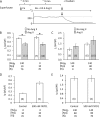Susceptibility of β1 Na+-K+ pump subunit to glutathionylation and oxidative inhibition depends on conformational state of pump
- PMID: 22354969
- PMCID: PMC3320985
- DOI: 10.1074/jbc.M112.340893
Susceptibility of β1 Na+-K+ pump subunit to glutathionylation and oxidative inhibition depends on conformational state of pump
Abstract
Glutathionylation of cysteine 46 of the β1 subunit of the Na(+)-K(+) pump causes pump inhibition. However, the crystal structure, known in a state analogous to an E2·2K(+)·P(i) configuration, indicates that the side chain of cysteine 46 is exposed to the lipid bulk phase of the membrane and not expected to be accessible to the cytosolic glutathione. We have examined whether glutathionylation depends on the conformational changes in the Na(+)-K(+) pump cycle as described by the Albers-Post scheme. We measured β1 subunit glutathionylation and function of Na(+)-K(+)-ATPase in membrane fragments and in ventricular myocytes. Signals for glutathionylation in Na(+)-K(+)-ATPase-enriched membrane fragments suspended in solutions that preferentially induce E1ATP and E1Na(3) conformations were much larger than signals in solutions that induce the E2 conformation. Ouabain further reduced glutathionylation in E2 and eliminated an increase seen with exposure to the oxidant peroxynitrite (ONOO(-)). Inhibition of Na(+)-K(+)-ATPase activity after exposure to ONOO(-) was greater when the enzyme had been in the E1Na(3) than the E2 conformation. We exposed myocytes to different extracellular K(+) concentrations to vary the membrane potential and hence voltage-dependent conformational poise. K(+) concentrations expected to shift the poise toward E2 species reduced glutathionylation, and ouabain eliminated a ONOO(-)-induced increase. Angiotensin II-induced NADPH oxidase-dependent Na(+)-K(+) pump inhibition was eliminated by conditions expected to shift the poise toward the E2 species. We conclude that susceptibility of the β1 subunit to glutathionylation depends on the conformational poise of the Na(+)-K(+) pump.
Figures








Similar articles
-
Oxidative inhibition of the vascular Na+-K+ pump via NADPH oxidase-dependent β1-subunit glutathionylation: implications for angiotensin II-induced vascular dysfunction.Free Radic Biol Med. 2013 Dec;65:563-572. doi: 10.1016/j.freeradbiomed.2013.06.040. Epub 2013 Jun 28. Free Radic Biol Med. 2013. PMID: 23816524 Free PMC article.
-
Reversible oxidative modification: a key mechanism of Na+-K+ pump regulation.Circ Res. 2009 Jul 17;105(2):185-93. doi: 10.1161/CIRCRESAHA.109.199547. Epub 2009 Jun 18. Circ Res. 2009. PMID: 19542013
-
Glutathionylation-Dependence of Na(+)-K(+)-Pump Currents Can Mimic Reduced Subsarcolemmal Na(+) Diffusion.Biophys J. 2016 Mar 8;110(5):1099-109. doi: 10.1016/j.bpj.2016.01.014. Biophys J. 2016. PMID: 26958887 Free PMC article.
-
Oxidative regulation of the Na(+)-K(+) pump in the cardiovascular system.Free Radic Biol Med. 2012 Dec 15;53(12):2263-8. doi: 10.1016/j.freeradbiomed.2012.10.539. Epub 2012 Oct 17. Free Radic Biol Med. 2012. PMID: 23085513 Review.
-
Redox-dependent regulation of the Na⁺-K⁺ pump: new twists to an old target for treatment of heart failure.J Mol Cell Cardiol. 2013 Aug;61:94-101. doi: 10.1016/j.yjmcc.2013.05.013. Epub 2013 May 30. J Mol Cell Cardiol. 2013. PMID: 23727392 Review.
Cited by
-
Carbonylation Modification Regulates Na/K-ATPase Signaling and Salt Sensitivity: A Review and a Hypothesis.Front Physiol. 2016 Jun 28;7:256. doi: 10.3389/fphys.2016.00256. eCollection 2016. Front Physiol. 2016. PMID: 27445847 Free PMC article. Review.
-
Oxidative inhibition of the vascular Na+-K+ pump via NADPH oxidase-dependent β1-subunit glutathionylation: implications for angiotensin II-induced vascular dysfunction.Free Radic Biol Med. 2013 Dec;65:563-572. doi: 10.1016/j.freeradbiomed.2013.06.040. Epub 2013 Jun 28. Free Radic Biol Med. 2013. PMID: 23816524 Free PMC article.
-
Protein glutathionylation in cardiovascular diseases.Int J Mol Sci. 2013 Oct 17;14(10):20845-76. doi: 10.3390/ijms141020845. Int J Mol Sci. 2013. PMID: 24141185 Free PMC article. Review.
-
Protein kinase-dependent oxidative regulation of the cardiac Na+-K+ pump: evidence from in vivo and in vitro modulation of cell signalling.J Physiol. 2013 Jun 15;591(12):2999-3015. doi: 10.1113/jphysiol.2013.252817. Epub 2013 Apr 15. J Physiol. 2013. PMID: 23587884 Free PMC article.
-
Displacement of Native FXYD Protein From Na+/K+-ATPase With Novel FXYD Peptide Derivatives: Effects on Doxorubicin Cytotoxicity.Front Oncol. 2022 Mar 17;12:859216. doi: 10.3389/fonc.2022.859216. eCollection 2022. Front Oncol. 2022. PMID: 35371992 Free PMC article.
References
-
- Figtree G. A., Liu C. C., Bibert S., Hamilton E. J., Garcia A., White C. N., Chia K. K., Cornelius F., Geering K., Rasmussen H. H. (2009) Reversible oxidative modification. A key mechanism of Na+-K+ pump regulation. Circ. Res. 105, 185–193 - PubMed
-
- Shimon M. B., Goldshleger R., Karlish S. J. (1998) Specific Cu2+-catalyzed oxidative cleavage of Na, K-ATPase at the extracellular surface. J. Biol. Chem. 273, 34190–34195 - PubMed
Publication types
MeSH terms
Substances
LinkOut - more resources
Full Text Sources
Research Materials
Miscellaneous

